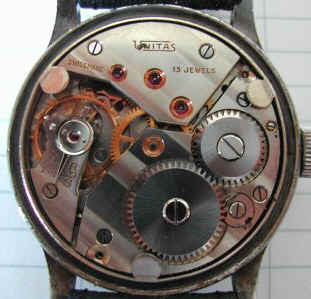
In 1898, Auguste Reymond established his watch company, Manufacture Auguste Reymond in the small town of Tramelan in the center of the Jura Mountain region of Switzerland. He also began to manufacture movement blanks, or ebauches, in 1906. Reymond later gave the name of these ebauches UNITAS, after the UNITAS Watch Company he acquired in 1926. The Depression precipitated by the American Stock Market crash of the late 1920s and early 1930s was felt throughout Europe. The Depression had a profound effect on the Swiss watch industry and August Reymond S.A. did not go unscathed. Sales of his watches plumeted and Reymond was forced to sell his company to a group of investors who managed to keep the company financially viable.
Fortunately, Ebauches SA had been formed in 1926 in Neuchatel as a holding company that brought together Switzerland's largest ebauche firms, which included Valjoux S.A., ETA S.A., Felsa S.A., Venus S.A. and others. Fabrique d'Ebauches Unitas S.A. joined this confederation in 1932. Ebauches SA proved vital to the survival of the ebauche industry in Switzerland. Naturally, Reymond did not make Unitas movements for his watches only, but sold them to other watch manufacturers in Switzerland, just as other ebauche manufacturers did. This helped the company's financial bottom line.
His watch firm's complete name, Auguste Reymond, S.A. was the source of the name for his watches, the acronym ARSA. Reymond also manufactured watches under the UNITAS name. Each Swiss ebauche is stamped with its own unique symbol to identify the manufacturer. The Swiss adopted a stylized shield, within which the ebauche manufacturer would place a letter or letters, or a symbol. The UNITAS stamp used the letter U with a T within, placed within the shield outline (above photo). The caliber number was also stamped on the ebauche.
ARSA pocket and wristwatches and UNITAS wristwatches were coveted for their accuracy and appreciated for their affordability and style. Over the course of the 20th century, many travelers to Switzerland who owned these watches would travel by train to Tramelan to see the Manufacture Auguste Reymond and perhaps peer into the workshops to see the master watchmakers at work.
In the early 1930s, the Incabloc® movement shock absorber was developed, and it revolutionized movement durability and maintaining accuracy. It was adopted by virtually all Swiss movement manufacturers. It has been refined over the decades since and is the premier method of protecting Swiss watches from severe shock. UNITAS incorporated the Incabloc® system in their movements. Among them is the UNITAS 6497 and 6498 pocketwatch movements designed in the 1950s. The 6497 and 6498 calibers became regarded as among the best pocketwatch movements ever designed for their ruggedness and accuracy.
Along with the UNITAS 6497 and 6498 movements, the company also developed braille wrist and pocket watches for the blind, and a line of "jumping hours" watches with unique hour indication on the dial which were also developed during the 1950s. The fifties, sixties and seventies were the golden decades of Swiss watchmaking when the industry experienced unprecedented prosperity. The August Reymond S.A. building had become landmark in Tramelan and one of the largest employers in the town. However, a technological revolution was brewing that would shake the Swiss watch industry to its foundations.
When SMH was formed in 1983, Ebauches SA became ETA SA Fabriques d'Ebauches. This proved vital to the survival of the watch industry with the onslaught of the quartz revolution in the late 1970s and early 1980s. Auguste Reymond S.A. however, did not survive the arrival of inexpensive and highly accurate quartz movements. Sales of mechanical watches plunged while watches with quartz movements soared. The company had to be liquidated and its assets sold off. The tools and related equipment for the UNITAS 6497 and 6498 pocket watch movements were acquired by ETA. With the consolidation of the Swiss watch industry during this tumultuous period, many smaller watch companies closed their doors, unable to compete with inexpensive Japanese quartz movements. When Ebauches S.A. absorbed Unitas, Valljoux and other manufacturers within ETA S.A, many of the original ebauche names and calibre numbers were retained. That is why today, the UNITAS 6497 and 6498 calibers and the Valljoux 7750 and 7751 calibers manufactured by ETA still carry the name and caliber number of the original ebauche manufacturer.
Fortunately, James Choffat, a former manager of the company, managed to purchase much of the company's parts, movements, tools and equipment in an effort to keep the Auguste Reymond name alive. It was no longer feasible for the surviving company to remain in the same building it had occupied since 1910. Manufacturer Auguste Reymond moved from its original building to a smaller, more modern building in Tramelan and in 1989 the company was purchased by Nitella S.A. another watch factory in Tramelan. Today, it is under the direction of Thomas Loosli. Many of the newer models in the Auguste Reymond catalog are his designs.
The UNITAS 6497 is experiencing a resurgence today as a movement for wristwatches. At a whopping 16.5 ligne, it requires a massive case--just the thing for those wanting a manly watch. Both the UNITAS 6497 and 6498 movements remain the premier movements for mechanical pocket watches. A couple of years ago, Auguste Reymond began to offer a limited edition series of wristwatches, using original, new old stock UNITAS movements that have been, in the words from their current catalog, "...thoroughly restaured, redecorated and individually numbered." The limited edition model for 1999 was the Ballad, using the UNITAS 6580 hand-wound movement manufactured in the 1960s with date at three oclock and small second hand at six oclock. The Ballad features a rectangular, sculpted case with round saphire caseback so the beautiful 17 jewel movement can be seen. Production was limited to 999 pieces. The creativity and quality of August Reymond pocket watches and wristwatches will ensure this company will be around well into this new millennium.

No comments:
Post a Comment